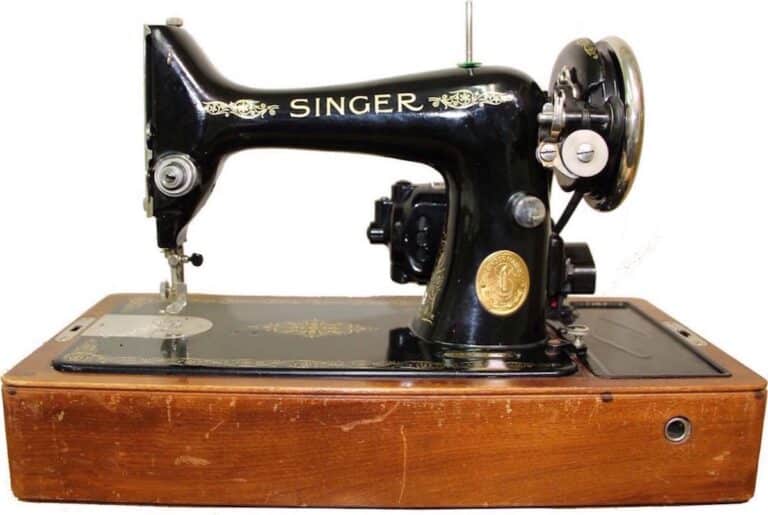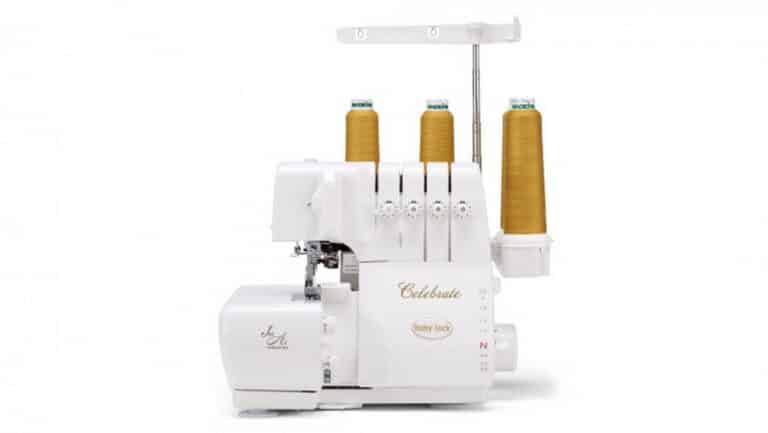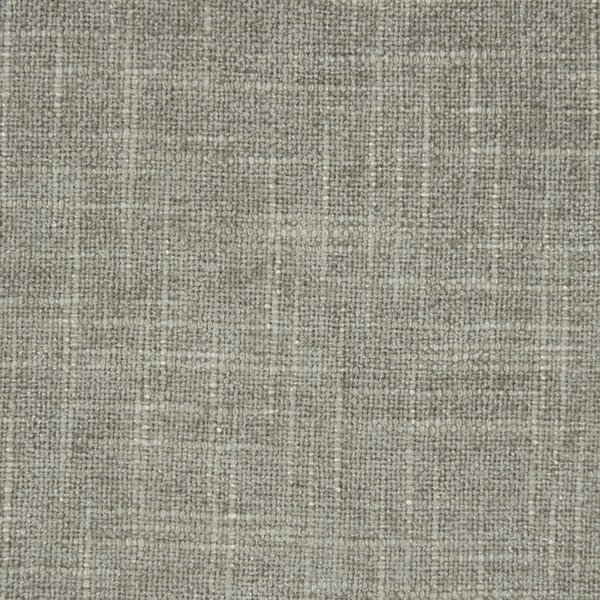Embroidery Sewing Machine Maintenance – How to Keep Your Equipment in Top Shape
Today, I want to chat with you about the importance of proper maintenance for your embroidery sewing machine. It’s crucial to keep your equipment in top shape to avoid costly repairs and ensure beautiful, high-quality stitching. I’ll be sharing some essential tips and tricks for keeping your machine running smoothly and maintaining its longevity. So, grab a cup of tea and let’s dive into the world of embroidery sewing machine maintenance!
Table of Contents
Key Takeaways:
- Regular cleaning: Keeping your embroidery sewing machine clean is essential for its proper functioning. Dust and lint can build up and cause problems, so be sure to clean your machine regularly to keep it in top shape.
- Oil regularly: Proper lubrication is crucial for the smooth operation of your sewing machine. Be sure to oil your machine according to the manufacturer’s recommendations to prevent friction and wear.
- Professional servicing: While regular maintenance tasks are important, it’s also crucial to have your embroidery sewing machine professionally serviced on a regular basis. This will help to catch any potential issues before they become major problems, and keep your equipment running smoothly for years to come.
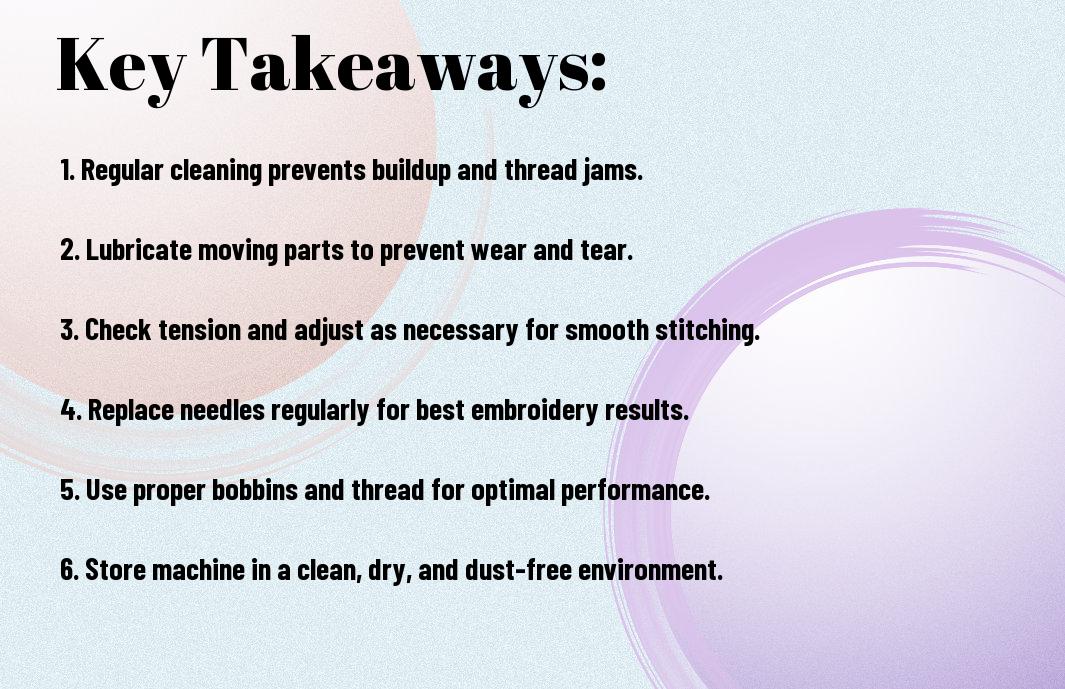
Setting the Stage for Success
Clearly, keeping your embroidery sewing machine in top shape is essential for producing high-quality work. To get started, it’s important to understand your equipment and create a regular maintenance schedule.
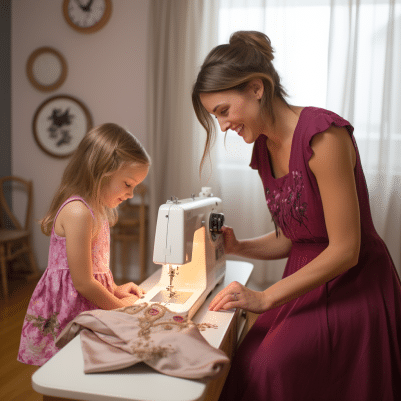
Understanding Your Embroidery Sewing Machine
When it comes to understanding your embroidery sewing machine, I’ve found that taking the time to read the user manual can be incredibly helpful. Familiarize yourself with the different parts of the machine, such as the needle, bobbin, and tension settings. Knowing how each part functions will make it easier to troubleshoot any issues that may arise. Additionally, I recommend reaching out to a manufacturer or joining a sewing community to gain insights and tips from experienced sewers.
Creating a Maintenance Schedule
To ensure that your embroidery sewing machine remains in top shape, I find it’s crucial to create a maintenance schedule. I recommend setting aside time every month to clean and oil the machine. Regularly changing the needles and bobbins is also essential for preventing stitching issues. I’ve found that keeping a log of when I perform maintenance tasks helps me stay on track and ensures that my machine is always in top working condition.
Daily Maintenance Habits
However, there are a few daily maintenance habits that I follow to keep my embroidery sewing machine in top shape. By incorporating these simple tasks into your daily routine, you can ensure that your equipment continues to perform at its best for years to come.
Dusting Off Your Embroidery Machine
One of the most important daily maintenance tasks is to **dust off** your embroidery machine. Dust and lint can accumulate in the nooks and crannies of the machine, affecting its performance over time. To prevent this, I recommend using a soft brush or a can of compressed air to gently remove any debris from the machine’s exterior and interior. This will help to prevent clogs and ensure that your machine continues to run smoothly.
Properly Oiling Your Machine
Another crucial daily maintenance habit is to **properly oil** your embroidery machine. Keeping the moving parts of your machine well-lubricated is essential for its longevity and performance. I make sure to refer to my machine’s manual for guidance on which parts need oiling and how often it should be done. By doing this regularly, you can reduce the risk of friction and wear, ensuring that your machine operates at its best.
Periodic Check-Ups
Your embroidery sewing machine requires regular maintenance to ensure it stays in top shape. Periodic check-ups are essential to catch any issues before they become major problems. By performing these routine checks, you can keep your equipment running smoothly and avoid costly repairs.
Inspecting Machine Parts for Wear
When conducting a periodic check-up, it’s important to inspect your machine parts for wear and tear. This includes the needle, bobbin case, presser foot, and any other moving components. Look for signs of wear, such as fraying or bending. If you notice any damage, be sure to replace the affected parts right away. Ignoring worn-out components can lead to poor stitching quality and potentially cause damage to the machine.
Tension and Needle Health Checks
Another crucial part of a periodic check-up is testing the tension and needle health. Check the tension settings to ensure they are properly adjusted for the type of fabric you will be working with. Incorrect tension can result in uneven stitches and thread breakage. Additionally, inspect the needle for any signs of bending or dullness and replace it if necessary. A damaged needle can cause stitching issues and even damage your fabric.
Troubleshooting Common Issues
Now that you know the basics of embroidery sewing machine maintenance, let’s tackle some common issues that you may encounter while using your equipment. These problems can be frustrating, but with a little troubleshooting, you’ll be back to creating beautiful embroidery in no time.
Dealing with Thread Breaks
One of the most common issues with embroidery sewing machines is thread breaks. This can happen for a variety of reasons, such as using the wrong type of thread or needles, improper tension settings, or a dull needle. To troubleshoot this issue, start by checking your thread and needle to make sure they are compatible. Then, double-check your tension settings to ensure they are correct for the type of fabric and thread you are using. Finally, make sure to regularly change your needles to prevent dullness and thread breaks.
Resolving Embroidery Machine Stitches Problems
Another common issue you may encounter is stitches problems, such as skipped stitches, birdnesting, or uneven stitching. This can be caused by a variety of factors, including improper threading, incorrect needle size, or machine timing issues. If you’re experiencing stitches problems, start by rethreading your machine and checking the needle size. If the issue persists, it may be time to have your machine professionally serviced to address any timing or mechanical issues.
I hope you find these troubleshooting tips helpful in keeping your embroidery sewing machine in top shape. Remember, regular maintenance and proper troubleshooting can help you avoid costly repairs and keep your equipment running smoothly for years to come.
Long-Term Care and Storage
Lastly, let’s talk about how to take care of your embroidery sewing machine for the long term. Proper long-term care and storage practices can help extend the life of your equipment and keep it in top shape for many years to come.
Preparing Your Machine for a Break
When you know you won’t be using your embroidery sewing machine for an extended period of time, it’s important to prepare it for storage. Start by giving it a thorough cleaning to remove any dust, lint, or thread buildup. This will help prevent any potential clogs or damage while the machine is not in use. Additionally, I recommend oiling the machine according to the manufacturer’s instructions to keep the internal parts lubricated and prevent corrosion. Finally, cover your machine with a dust cover or fabric to protect it from any potential damage during storage.
Ideal Storage Practices
Proper storage is crucial for preserving the condition of your embroidery sewing machine. When storing your machine, keep it in a cool, dry place away from direct sunlight, extreme temperatures, and humidity. Store it in a sturdy, protective case or bag to shield it from dust, moisture, and potential impacts. Additionally, I highly recommend storing your machine in a location where it won’t be jostled or knocked over to prevent any damage. By following these storage practices, you can ensure that your machine will be in top condition when you’re ready to use it again.
Embroidery Sewing Machine Maintenance – How to Keep Your Equipment in Top Shape
Now that you know all the tips and tricks for keeping your embroidery sewing machine in top shape, you can confidently tackle any project without worrying about equipment maintenance. Remember to clean and oil your machine regularly, change the needles and bobbins when needed, and always store your machine in a dust-free environment. By following these simple maintenance tasks, you can extend the life of your equipment and enjoy hassle-free sewing and embroidery for years to come! Happy sewing!
Embroidery Sewing Machine Maintenance – How to Keep Your Equipment in Top Shape
Q: What is the best way to clean and oil my embroidery sewing machine?
A: The best way to clean your embroidery sewing machine is to use a soft brush to remove any dust and lint from the machine, especially around the feed dogs and bobbin area. After cleaning, use a small amount of sewing machine oil to lubricate the moving parts, following the manufacturer’s instructions. Regular cleaning and oiling will keep your machine running smoothly.
Q: How often should I have my embroidery sewing machine serviced?
A: It is recommended to have your embroidery sewing machine serviced at least once a year, even if you use it infrequently. A professional technician can clean and lubricate internal parts, check for any signs of wear, and make any necessary adjustments to keep your machine in top working condition.
Q: What can I do to prevent thread breakage and needle issues with my embroidery sewing machine?
A: To prevent thread breakage and needle issues, always use high-quality embroidery thread and needles that are compatible with your machine. Check the tension settings and make sure the needle is inserted correctly. Keep your machine clean and free of lint, and avoid using old or damaged thread. By taking these precautions, you can minimize the risk of thread breakage and needle issues while embroidering.



